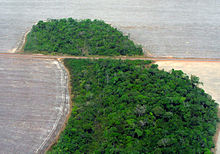Flying river

The flying river is a movement of large quantities of
Concept
An average forest tree will release 1000 litres (220 imp gal; 264 US gal) of water vapor into the atmosphere every day.[1] It has been found that whereas every square metre of the surface of the sea evaporates one litre of water each day, the same area of forest evaporates about eight times as much because of the multiple layers of foliage in the crown of the trees.[2] The main airflow in the Amazon basin is towards the southwest. When this air mass reaches the Andes, the mountain range acts as a "natural barrier", redirecting huge volumes of humid air towards the Amazon regions of Colombia, Ecuador, north and south of Peru, central and southern Brazil as well as towards northern Argentina, Paraguay, and Uruguay, and rain falls in these areas. Some part of this air manages to surmount the cordillera and deposits rain in the west of Peru. Other air masses travel northwards from the Amazon basin, passing over Colombia, Venezuela, Guyana, French Guiana, and Suriname.[1]
Climatic consequences of deforestation

In 2009 Antonio Nobre, a Brazilian climate scientist, stated that without the flying river, much of southern Brazil, which produces approximately 70% of the country's
Flying Rivers Project
With its large surface area and abundant rainfall, Brazil receives more rain in a year (estimated at 15,000 cubic kilometres (3,600 cu mi)) than any other country.[4] In 2007, the Swiss-Brazilian pilot Gérard Moss joined with scientists to initiate a project to evaluate the source of the atmospheric water over Brazil and examine the possibility that recent droughts in the country are being caused by the deforestation of the Amazon rainforest. This is the Flying Rivers Project. The primary objective of the project is to "try to ascertain the origin of the water vapour, rainwater and river water in the areas crossed by the flying rivers". Other objectives are to scientifically evaluate the processes involved in this water transfer and to educate the public in understanding the importance of the Amazon rainforest as a source of the water that is vital for their lives and the economy.[4]
References
- ^ a b Yana Marull (2012-09-18). "Amazon's flying water vapor rivers bring rain to Brazil". Phys.org. Retrieved 2014-11-13.
- ^ Thays Prado (2010-03-18). "Rios voadores a todo vapor" (in Spanish). Planeta Sustentável. Archived from the original on 2012-03-30. Retrieved 2014-11-13.
- ^ Rocha, Jan (2014-09-15). "Drought bites as Amazon's 'flying rivers' dry up". The Guardian. Retrieved 2014-11-15.
- ^ a b "The Flying Rivers Project". Expedicao Rios Voadores. Retrieved 2014-11-13.
